Don't wanna be here? Send us removal request.
Link

Recruitment refers to the overall process of identifying, attracting, screening, shortlisting, and interviewing candidates for jobs (either permanent or temporary) within an organization. Recruitment can also refer to the processes involved in choosing individuals for unpaid roles. Managers, Hr Recruitment Agency, and recruitment specialists may be tasked with carrying out recruitment, but in some cases, public-sector employment, commercial recruitment agencies, or specialist search consultancies are used to undertake parts of the process. Internet-based technologies which support all aspects of recruitment have become widespread, including the use of artificial intelligence (AI). An employment agency is an organization that matches employers to employees. In developed countries, there are multiple private businesses that act as employment agencies and publicly-funded employment agencies.
0 notes
Link

The first group of people to bake bread was ancient Egyptians, around 8000 BC. During the Middle Ages, it was common for each landlord to have a bakery, which was actually a public oven; Housewives would bring dough that they had prepared to the baker, who would tend the oven and bake them into bread. As time went on, bakers would also sell their own goods, and in that some bakers acted dishonestly, tricks emerged: for example, a baker might have trap door(s) in the oven or other obscured areas, that would allow a hidden small boy or another apprentice to take off some of the dough brought in for baking. Then the dishonest baker would sell bread made with the stolen dough as their own. This practice and others eventually lead to the famous regulation known as Assize of Bread and Ale, which prescribed harsh penalties for bakers that were found cheating their clients or customers. These days there are so many Bakery & Confectionery Products Sales and Marketing Agency in Pune. Today bakers work in varying environments both as employees and sometimes owning their own stores. The first bread maker was released in Japan in 1986 by the Matsushita Electric Industrial Co. (now Panasonic). A decade later they had become popular in the United Kingdom, Australia, and the United States. While not viable for commercial use due to the fixed loaf shape and the limited duty cycle, bread machines are very suitable for home use, producing their best results when dealing with kneaded dough. Bread making machine or bread maker is a home appliance for baking bread. It consists of a bread pan (or "tin"), at the bottom of which are one or more built-in paddles, mounted in the center of a small special-purpose oven. This small oven is usually controlled by a simple built-in computer, the settings for which are inputted at a control panel. Most bread machines have different cycles for different kinds of dough—including white bread, whole grain, European- style (sometimes labeled "French"), and dough-only (for pizza dough and shaped loaves baked in a conventional oven). Many also have a timer to allow the bread machine to activate without operator attendance, and some high-end models allow the user to program a custom cycle. Cake decorating is an art that is performed in places all over the world. That is why contests and baking show competitions are very popular, especially in the Western World. Cake decorating is one of the sugar arts that uses icing or frosting and other edible decorative elements to make plain cakes more visually interesting. Alternatively, cakes can be molded and sculpted to resemble three-dimensional persons, places, and things. There are many themes of cakes, such as wedding cakes, birthday cakes, seasons, and holidays. Cakes may be baked and decorated for almost any social occasion. During the 1840s, the advent of temperature-controlled ovens and the production of baking soda and baking powder made baking cakes much easier.
Even though baking from scratch decreased during the latter part of the 20th century in the United States, decorated cakes have remained an important part of celebrations such as weddings, anniversaries, birthdays, showers, and other special occasions. Recently, cakes decorated with fondant have become extremely popular and resulted in several reality-based TV shows across the country.
0 notes
Link
Freezing is one of the oldest and most commonly used means of food preservation. It has been known to be an extremely effective means of preserving food for extended periods since Paleolithic and Neolithic times when man used ice and snow to cool food. The cooling effect of salt and ice was first publicly discussed in 1662 by the chemist Robert Boyle, but this technology was certainly known in Spain, Italy and India in the sixteenth century. The manufacture of ice in shallow lakes using radiant ‘night cooling’ and the preservation of ice and snow in ice houses was a common practice in large country houses in Victorian times. Ice was a product only for the privileged, and iced desserts were extremely fashionable and a sign of great wealth.
0 notes
Photo

Cooking Spices and Masala Sales and Marketing Agency in Pune
India is the land of spices and could exploit the fast-growing nutraceutical sector with her high intrinsic quality spices. The scope of spices like turmeric, ginger, fenugreek, garlic, and red pepper in the nutraceutical industry with their possible role in the control/prevention of important health disorders. Non-traditional use of spices including nutraceuticals now accounts for nearly 15% of spice production in the country. The new lines of applications are growing at a rate of 10-12%, according to Spices Board officials. Nutraceutical and life sciences companies and R&D Labs are beginning to tap the healing, nutritive and health benefits of spices. This segment has opened out various possibilities of using spices to create fortified foods and organic medicine. The demand for nutraceutical products has gone up as more people are turning to natural products for treating lifestyle diseases. The nutraceutical sector is growing at 12-14 % in the U.S., 8-10 % in Europe, 14% in China, and almost 9% in Japan, while it is still at a nascent stage in India. At the same time, the growth in the food industry globally, where spices are traditionally used, is 3-5 %.
Cooking Spices and Masala Sales and Marketing Agency in Pune
USA, Canada, Germany, Japan, Saudi Arabia, Kuwait, Bahrain, and Israel are the main markets for Indian spices. Mexico continues to be the major importer of cinnamon and cassia while Saudi Arabia, Bahrain, Kuwait, and Israel are the major markets for green cardamom, black pepper, ginger, and turmeric. We have a near-monopoly in spice oils and oleoresins and Indian spices have obtained geographical indicators such as Malabar pepper, Alleppey green cardamom, Coorg green cardamom, and Naga chili.
0 notes
Photo

Pickles And Chutney Marketing Agency
Man is a sophisticated being and he is not satisfied by eating just wholesome and nutritious foods. He requires spicy adjuncts along with his food to make it palatable so that he can enjoy his meal. In this context pickles - an adequately spiced unfermented preparation – has gained importance in the Indian menu and occupies a special place. There are many pickles and chutney marketing agencies now. Preservation of fruits and vegetables in the form of pickles is an old art and a variety of these products are made in Indian homes and consumed. However, the taste and method of preparation varied, though the basic principle of pickling i.e. curing prepared fruits and vegetables by salting, acidifying, addition of vinegar and/or by using oil, and in almost all cases mixing of spice powders of a varied composition. Pickles are of different types: pickle in oil, pickle in citrus juice, pickle in brine and pickle in vinegar. Fruit chutney is a preserved product similar to a pickle, which contains a minimum of 40% of fruit content and 50% of solids (TSS) and with acidity not more than 20%. It is a product of Western preference and hence spiced less. Both pickles and chutneys are consumed along with staple foods such as rice, chapathi, bread, samosa, upma, etc. as a side dish to increase appetite. The market for pickles and chutneys are on the increasing side in both domestic and export markets. The present production of pickles and chutneys is about 50,000 MT valued to Rs.100-150 crore per annum of which substantial quantity is exported.
Fruits and vegetables are available during different seasons, which vary from product to product, in abundance. Green mangoes- Feb. to May, Tomatoes – July to Oct. & Dec. to March, Acid limes – Dec. to March & July to Sept., Green chillies – Almost throughout the year, Carrot – July to Feb. and so on. The raw materials are to be processed during the season, prepared, cured, dehydrated and stored for ready use all round the year. Powdered spices are the other raw materials of importance in instant pickles preparation. Good quality dry spices only are to be used. They are cleaned, sun dried/mechanically dried and ground to the required particle size and used as freshly ground spices. Edible oil such as sesame oil/mustard oil has to be used. Glacial acetic acid can be used instead of vinegar (with required dilution). Dry powdered salt is to be used. All the materials can be locally procured. Packaging materials also form an important input like glass bottles, caps, flexible pouches and so on.
Fully matured fresh raw mangoes/limes/other fruits and vegetables are washed and cut into uniform sizes, brine cured at optimal conditions or can be used directly for mixing salt and other ingredients and preparing the pickle. Cleaned and dried spices like red chillies, turmeric and mustard are ground separately and are mixed with the cured or selected edible oil (with seasoning added and fried in it), garlic, ginger paste, vinegar, etc. The prepared fresh pickles have to be cured for a week in plastic carboys or wooden barrels. Periodical mixing will help for quick and uniform salt equilibration. The cured pickles are then packed in dry bottles, sealed with cap and labeled, packed in CFB boxes and dispatched for sale. The fruit chutney is made by cooking the prepared pieces with sugar, spice extractives, etc. to a required consistency, sugar percentage and acidity, finally finishing it with the required quantity of vinegar. Then packed in bottles as in case of pickles. F.P.O Licence has to be obtained and the production has to be done under good manufacturing practice.
0 notes
Photo
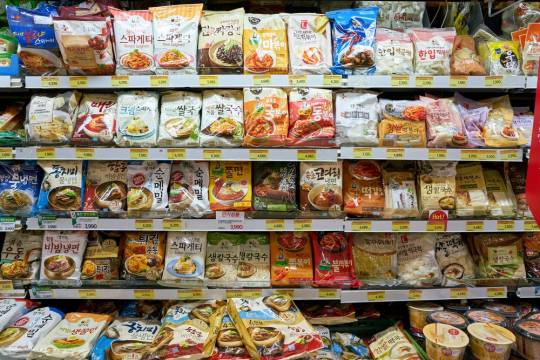
Ready To Eat Instant Food Mixes Marketing Sales Agency In Pune & Mumbai
Instant foods are convenience foods which require minimal preparation, typically just adding water or milk. Some authors define "instant" food as requiring less than five minutes of preparation and "ultra-instant food" as requiring less than one minute. Instant foods are often dehydrated, freeze-dried, or condensed.
Ready To Eat Instant Food Mixes Sale And Marketing Agency
There is an endless list of instant food and beverages. The best part of this is, its number of varieties for all types of age groups i.e; from a baby to an old person.
0 notes
Link
Namkeen is the Hindi word used to describe a savory flavor. The word namkeen is derived from the word Namak (meaning salt). Namkeen is also used as a generic term to describe savory snack foods. Both black and regular white salt are used in Indian cooking, which gives it the salty flavor many people like. Other namkeen snacks common in Indian cuisine include khaara, farsan, chivda, sav, chips and bhujia. Namkeen of Indore and Ratlam are two snacks that are very well known for their tastes.
Dalmoth, Chanachur & Bhujia are the important names of salted snacks. These are very tasty and flavoring. These are used during tea and drink hours. Dalmoth is a traditional namkeen, dry snack, it is one of the popular snacks in North India made from fried lentils, nuts, spices and sev. Dal moth is a mixture of fried lentils, nuts, Indian spices with some tangy and spicy flavors. In Gujarat, during the Diwali festival, people make it at home and celebrate the festival of joy.
0 notes
Photo
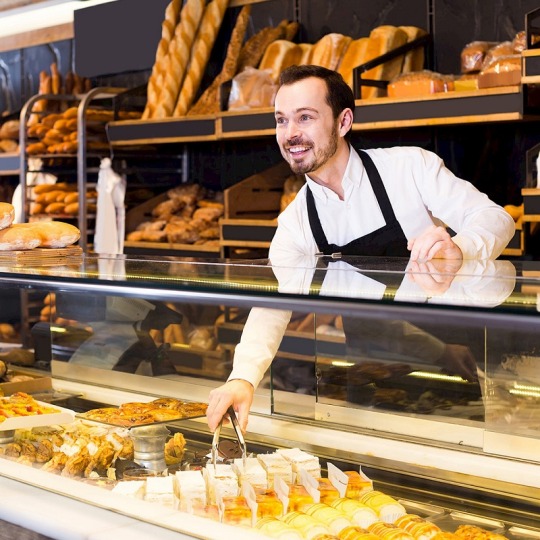
Bakery & Confectionery Products Sales & Marketing Agency
A bakery (or baker's shop) is an establishment that produces and sells flour-based food baked in an oven such as bread, cakes, pastries, and pies. Some retail bakeries are also cafés, serving coffee and tea to customers who wish to consume the baked goods on the premises.
Some bakery shops provide services for special occasions such as weddings, birthday parties, anniversaries, or even business events. Bakery shops can provide a wide range of cake designs such as sheet cakes, layer cakes, tiered cakes, and wedding cakes. Other bakeries may specialize in traditional or hand made types of bread made with locally milled flour, without flour bleaching agents or flour treatment agents, baking what is sometimes referred to as artisan bread. These days there are so many Bakery & Confectionery Products Sales and Marketing Agency in Mumbai.
While grocery stores and supermarkets in many countries now carry prepackaged, pre-sliced bread and cakes, or offer in store baking and basic cake decoration, some people may prefer to get their baked goods from a specialist baker's shop, either out of tradition, for the availability of a greater variety of baked goods, or from the higher quality practice of the trade of baking.
Bakery & Confectionery Products Sales and Marketing Agency in pune
A baker is someone who makes, bakes and sells breads, rolls, biscuits or cookies, and/or crackers using an oven or other concentrated heat source. Cakes and similar foods may also be produced, as the traditional boundaries between what is produced by a baker as opposed to a pastry chef have blurred in recent decades. The place where a baker works is called a bakery.
0 notes
Photo
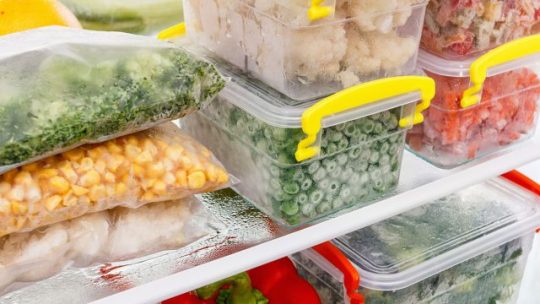
Frozen Food Products Sales and Marketing Agency in Mumbai
Frozen food preserves it from the time it is prepared to the time it is eaten. Since early times, farmers, fishermen, and trappers have preserved grains and produce in unheated buildings during the winter season. Freezing food slows decomposition by turning residual moisture into ice, inhibiting the growth of most bacterial species.
Freezing is an effective form of food preservation because the pathogens that cause food spoilage are killed or do not grow very rapidly at reduced temperatures. The process is less effective in food preservation than are thermal techniques, such as boiling, because pathogens are more likely to be able to survive cold temperatures rather than hot temperatures.One of the problems surrounding the use of freezing as a method of food preservation is the danger that pathogens deactivated (but not killed) by the process will once again become active when the frozen food thaws.
Frozen Food Product sales agency in Mumbai
Usually, there are two processes: mechanical and cryogenic or flash freezing.The freezing kinetics is important to preserve the food quality and texture. Quicker freezing generates smaller ice crystals and maintains cellular structure.Quicker freezing generates smaller ice crystals and maintains cellular structure. Cryogenic freezing is the quickest freezing technology available due to the ultra low liquid nitrogen temperature −196 °C (−320 °F).
Frozen Food Products Sales and Marketing Agency in Pune
These days there are so many agencies available. Preserving food in domestic kitchens during modern times is achieved using household freezers. Accepted advice to householders was to freeze food on the day of purchase. An initiative by a supermarket group in 2012 (backed by the UK’s Waste & Resources Action Programme) promotes the freezing of food “as soon as possible up to the product’s ‘use by’ date”. The Food Standards Agency was reported as supporting the change, provided the food had been stored correctly up to that time.
0 notes
Photo
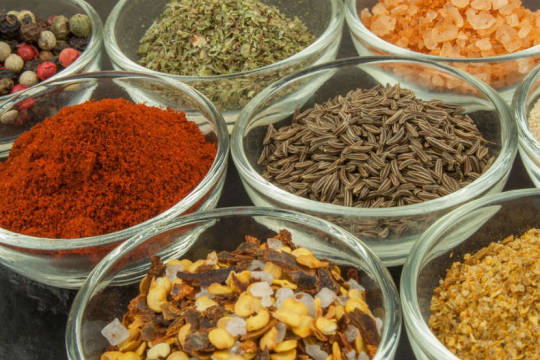
Cooking Spices and Masala Sales and Marketing Agency in Mumbai & Pune
A spice is a seed, fruit, root, bark, or other plant substance primarily used for flavoring or coloring food. Spices are distinguished from herbs, which are the leaves, flowers, or stems of plants used for flavoring or as a garnish. Spices are sometimes used in medicine, religious rituals, cosmetics or perfume production.
The spice trade developed throughout the Indian subcontinent by at earliest 2000 BCE with cinnamon and black pepper, and in East Asia with herbs and pepper. The Egyptians used herbs for mummification and their demand for exotic spices and herbs helped stimulate world trade. The word spice comes from the Old French word espice, which became epice, and which came from the Latin root spec, the noun referring to "appearance, sort, kind": species has the same root.
Cooking Spices and Masala Sales and Marketing Agency in Mumbai
Indonesian merchants traveled around China, India, the Middle East, and the east coast of Africa. Arab merchants facilitated the routes through the Middle East and India. This resulted in the Egyptian port city of Alexandria being the main trading center for spices. The most important discovery prior to the European spice trade was the monsoon winds (40 CE).
Spices were among the most demanded and expensive products available in Europe in the Middle Ages, the most common being black pepper, cinnamon (and the cheaper alternative cassia), cumin, nutmeg, ginger and cloves. Given medieval medicine's main theory of humorism, spices and herbs were indispensable to balance "humors" in food, a daily basis for good health at a time of recurrent pandemics. In addition to being desired by those using medieval medicine, the European elite also craved spices in the Middle Ages.
Cooking Spices and Masala Sales and Marketing Agency in Pune
Spices are primarily used as food flavoring. They are also used to perfume cosmetics and incense. At various periods, many spices have been believed to have medicinal value. Finally, since they are expensive, rare, and exotic commodities, their conspicuous consumption has often been a symbol of wealth and social class.
The most popular explanation for the love of spices in the Middle Ages is that they were used to preserve meat from spoiling, or to cover up the taste of meat that had already gone off. This compelling but false idea constitutes something of an urban legend, a story so instinctively attractive that mere fact seems unable to wipe it out... Anyone who could afford spices could easily find meat fresher than what city dwellers today buy in their local supermarket.
0 notes
Photo
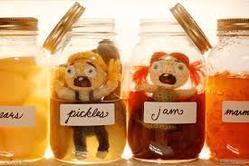
Pickles Jams Ketchups Sales And Marketing Agency In Mumbai And Pune
There are many varieties of fruit preserved globally, distinguished by method of preparation, type of fruit used, and place in a meal. Sweet fruit preserves such as jams, jellies and marmalades are often eaten at breakfast on bread or as an ingredient of a pastry or dessert, whereas more savory and acidic preserves made from "vegetable fruits" such as tomato, squash or zucchini, are eaten alongside savoury foods such as cheese, cold meats, and curries.
Food & Beverages Sales and Marketing Agency in Mumbai
In general, jam is produced by taking mashed or chopped fruit or vegetable pulp and boiling it with sugar and water. The proportion of sugar and fruit varies according to the type of fruit and its ripeness, but a rough starting point is equal weights of each.In general, jam is produced by taking mashed or chopped fruit or vegetable pulp and boiling it with sugar and water. The proportion of sugar and fruit varies according to the type of fruit and its ripeness, but a rough starting point is equal weights of each.
Another one is pickles. Raw mango pickle is fiery and sometimes sweet and sour. We will talk about raw mango dices that are used by Indian mothers to prepare pickle and panna.Despite using the same main ingredients, the differences in preparation techniques and spices can lead to a wide variation in Indian pickles. A mango pickle from South India may taste very different from one made in North India—the southern states prefer sesame oil and tend to produce spicier pickles, while the northern states prefer mustard oil.
In the United Kingdom, preparations of ketchup were historically and originally prepared with mushrooms as a primary ingredient, rather than tomatoes. Ketchup recipes began to appear in British and then American cookbooks in the 18th century. In a 1742 London cookbook, the fish sauce had already taken on a very British flavor, with the addition of shallots and mushrooms. The mushrooms soon became the main ingredient and from 1750 to 1850 the word "ketchup" began to mean any number of thin dark sauces made of mushrooms or even walnuts.
Many variations of ketchup were created, but the tomato-based version did not appear until about a century after other types. An early recipe for "Tomato Catsup" from 1817 includes anchovies and states:Commercial tomato ketchup has an additive, usually xanthan gum, which gives the condiment a pseudo plastic or "shear thinning" property - more commonly known as thixotropic. This increases the viscosity of the ketchup considerably with a relatively small amount added—usually 0.5%—which can make it difficult to pour from a container. However, the shear thinning property of the gum ensures that when a force is applied to the ketchup it will lower the viscosity enabling the sauce to flow. A common method to getting ketchup out of the bottle involves inverting the bottle and shaking it or hitting the bottom with the heel of the hand, which causes the ketchup to flow rapidly
A technique involves inverting the bottle and forcefully tapping its upper neck with two fingers (index and middle finger together). Specifically, with a Heinz ketchup glass bottle, one taps the 57 circle on the neck. This helps the ketchup flow by applying the correct shearing force. These techniques work because of how pseudoplastic fluids behave: their viscosity (resistance to flow) decreases with increasing shear rate. The faster the ketchup is sheared (by shaking or tapping the bottle), the more fluid it becomes. After the shear is removed the ketchup thickens to its original viscosity.
Ketchup is one of the many products that is leachable, meaning that the water within the product migrates together as the larger molecules within the product sediment, ultimately causing water to separate out. This forms a layer of water on top of the ketchup due to the molecular instability within the product.This instability is caused by interactions between hydrophobic molecules and charged molecules within the ketchup suspension.
0 notes
Photo
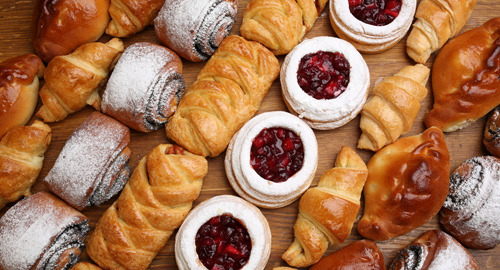
Bakery & Confectionery Products Sales and Marketing Agency in Mumbai
The first evidence of baking occurred when humans took wild grass grains, soaked them in water, and mixed everything together, mashing it into a kind of broth-like paste. The paste was cooked by pouring it onto a flat, hot rock, resulting in a bread-like substance. Later, when humans mastered fire, the paste was roasted on hot embers, which made bread-making easier, as it could now be made any time fire was created. The world's oldest oven was discovered in Croatia in 2014 dating back 6500 years ago.
Food & Beverages Sales and Marketing Agency in Mumbai
The Ancient Egyptians baked bread using yeast, which they had previously been using to brew beer. Bread baking began in Ancient Greece around 600 BC, leading to the invention of enclosed ovens. "Ovens and worktables have been discovered in archaeological digs from Turkey (Hacilar) to Palestine and date back to 5600 BC."
Eventually, the Roman art of baking became known throughout Europe and eventually spread to eastern parts of Asia. By the 13th century in London, commercial trading, including baking, had many regulations attached. In the case of food, they were designed to create a system "so there was little possibility of false measures, adulterated food or shoddy manufactures." There were by that time twenty regulations applying to bakers alone, including that every baker had to have "the impression of his seal" upon bread.
Art of baking enhances when Confectionery also gets added into it, together they give us a unique and tasty product.Bakers' confectionery, also called flour confections, includes principally sweet pastries, cakes, and similar baked goods. Baker's confectionery excludes everyday breads, and thus is a subset of products produced by a baker. The confectionery industry also includes specialized training schools and extensive historical records
Traditional confectionery goes back to ancient times and continued to be eaten through the Middle Ages into the modern era. Bakers' confectionery includes sweet baked goods, especially those that are served for the dessert course. Bakers' confections are sweet foods that feature flour as a main ingredient and are baked. Major categories include cakes, sweet pastries, doughnuts, scones, and cookies. In the Middle East and Asia, flour-based confections predominate.
Bakers' confectionery includes sweet baked goods, especially those that are served for the dessert course. Bakers' confections are sweet foods that feature flour as a main ingredient and are baked. Major categories include cakes, sweet pastries, doughnuts, scones, and cookies. In the Middle East and Asia, flour-based confections predominate.
Confections are defined by the presence of sweeteners. These are usually sugars, but it is possible to buy sugar-free candies, such as sugar-free peppermints. The most common sweetener for home cooking is table sugar, which is chemically a disaccharide containing both glucose and fructose. Hydrolysis of sucrose gives a mixture called invert sugar, which is sweeter and is also a common commercial ingredient. Finally, confections, especially commercial ones, are sweetened by a variety of syrups obtained by hydrolysis of starch. These sweeteners include all types of corn syrup.
Sugar confections include sweet, sugar-based foods, which are usually eaten as snack food. This includes sugar candies, chocolates, candied fruits and nuts, chewing gum, and sometimes ice cream. In some cases, chocolate confections are treated as a separate category, as are sugar-free versions of sugar confections.
Grocery stores and supermarkets, in many countries, sell prepackaged or pre-sliced bread, cakes, and other pastries. They may also offer in-store baking and basic cake decoration. Nonetheless, many people still prefer to get their baked goods from a small artisanal bakery, either out of tradition, the availability of a greater variety of baked products, or due to the higher quality products characteristic of the trade of baking.
1 note
·
View note
Photo

Ready To Eat Instant Food Mixes Marketing Sales Agency In Pune & Mumbai
Instant foods are convenience foods which require minimal preparation, typically just adding water or milk. Some authors define "instant" food as requiring less than five minutes of preparation and "ultra-instant food" as requiring less than one minute. Instant foods are often dehydrated, freeze-dried, or condensed.
Ready to Eat & Instant Food Sales and Marketing Agency in Pune
There is an endless list of instant food and beverages. The best part of this is, its number of varieties for all types of age groups i.e; from a baby to an old person. Some of them are:
Lets say, For babies, dehydrated baby food was produced by Gerber and Heinz in the 1980s. Dehydrated baby food products produced by both companies consisted of dehydrated food flakes. The Gerber product never came into fruition as a widely used product; it was only test-run in Omaha, Nebraska for around eight to nine months, and consumer adoption was not sufficient for the product to go into mass production.
0 notes
Photo
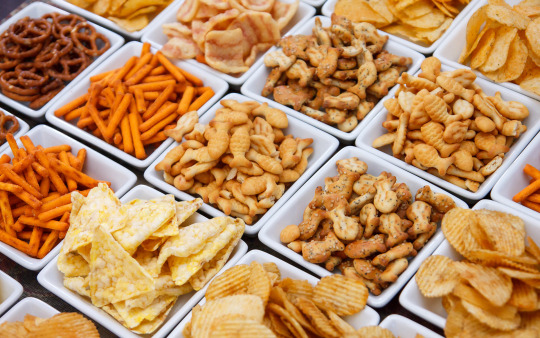
Snacks & Namkeen Sales and Marketing Agency in Mumbai & Pune
A snack is a small portion of food generally eaten between meals.Snacks come in a variety of forms including packaged snack foods and other processed foods, as well as items made from fresh ingredients at home.
Snack foods are typically designed to be portable, quick, and satisfying. Processed snack foods, as one form of convenience food, are designed to be less perishable, more durable, and more portable than prepared foods. They often contain substantial amounts of sweeteners, preservatives, and appealing ingredients such as chocolate, peanuts, and specially-designed flavors (such as flavored potato chips).
Snacks & Namkeen Sales and Marketing Agency in Pune
In the United States, a popular snack food is peanuts. Peanuts first arrived from South America via slave ships and became incorporated into African-inspired cooking on southern plantations. After the Civil War, the taste for peanuts spread north, where they were incorporated into the culture of baseball games and vaudeville theaters.
Along with popcorn (also of South American origin), snacks bore the stigma of being sold by unhygienic street vendors. The middle-class etiquette of the Victorian era (1837–1901) categorized any food that did not require proper usage of utensils as lower-class.
Traditional crackers are called krupuk, made from bits of shrimp, fish, vegetables or nuts, which are usually consumed as a crunchy snack or an accompaniment to meals.These crispy snacks are sometimes added to main dishes for their crunchy texture; several Indonesian dishes such as gado-gado, karedok, ketoprak, lontong sayur, nasi uduk, asinan and bubur ayam are known to require specific types of krupuk as toppings. There are wide variations of krupuk available across Indonesia. The most popular ones would be krupuk udang (prawn crackers) and krupuk kampung or kerupuk putih (cassava crackers).
Snacks & Namkeen Sales and Marketing Agency in Mumbai
Government bodies, such as Health Canada, recommend that people make a conscious effort to eat more healthy, natural snacks, such as fruit, vegetables, nuts, and cereal grains while avoiding high-calorie, low-nutrient junk food.
A 2010 study showed that children in the United States snacked on average six times per day, approximately twice as often as American children in the 1970s. This represents consumption of roughly 570 calories more per day than U.S. children consumed in the 1970s.
In the Middle East, one of the most important snacks that contains a huge amount of proteins is Lupinus, commonly known as lupin. Lupin contains around 33-40% protein.Another common snack in the Middle East is hummus made of chickpeas.
Another one is a Snack cakes are a type of baked dessert confectionery made with cake, sugar, and icing.
Snack cakes can be found in many American supermarkets and convenience stores, sold either individually or by the box. Examples include Drake's Devil Dogs, Twinkies and zebra cakes. Well-known American manufacturers of snack cakes include Hostess, Little Debbie, Dolly Madison, Tastykake and Drake's. In 2004, the snack-cake industry in the US experienced major consolidation, which resulted in fewer products being offered to consumers. For example, Dolly Madison zingers, Hostess brand Twinkies, and Drake's coffee cakes were all solely produced by the now-defunct Interstate Bakeries Corporation.
0 notes
Photo

These days Xylitol as substance adding in food is very common. It is basically a natural substance found in a variety of fruits and vegetables. Some of the most common xylitol- rich foods include: berries, mushrooms, corns, and lettuces, baked goods, peanut butter, drink powders, candy, pudding, ketchup, barbecue sauces, and pancake syrups. Xylitol In Food And Beverages
1 note
·
View note
Photo

These days Xylitol as substance adding in food is very common. It is basically a natural substance found in a variety of fruits and vegetables. Some of the most common xylitol- rich foods include: berries, mushrooms, corns, and lettuces, baked goods, peanut butter, drink powders, candy, pudding, ketchup, barbecue sauces, and pancake syrups. Xylitol In Food And Beverages
1 note
·
View note
Photo
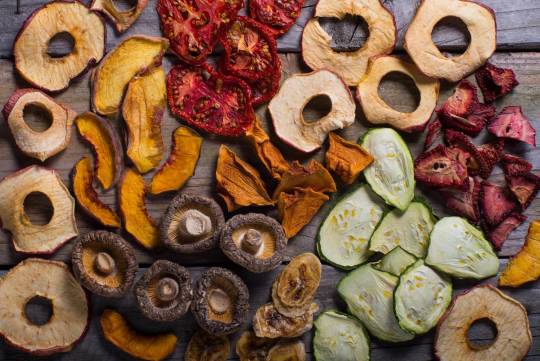
Dehydrated Veggies Magic
Dehydrated food is considered to be one of the best alternatives to many snacks. Also, you can add them to your salads, oatmeal, baked goods, and smoothies. They rehydrate in the liquid and adds lovely taste in your beverage.
4 notes
·
View notes